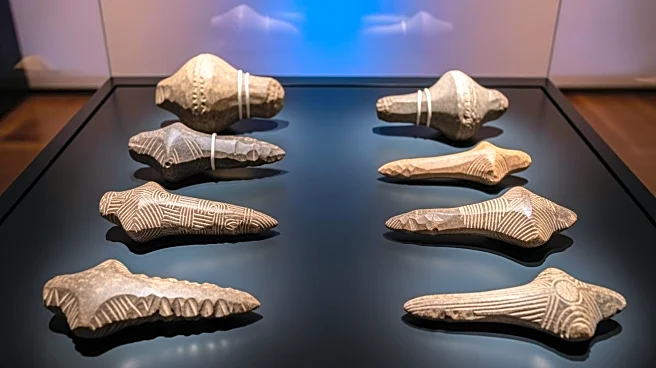What's Happening?
Researchers from George Washington University have uncovered evidence of early human technological innovation in the Turkana Basin, Kenya. The study, published in Nature Communications, reveals that hominins
crafted stone tools with precision nearly 2.7 million years ago, despite facing environmental challenges such as wildfires and droughts. These tools, described as the first multi-purpose 'Swiss Army knives,' date from approximately 2.75 to 2.44 million years ago. The research highlights the resilience of early humans in maintaining consistent tool-making practices amidst shifting landscapes from lush wetlands to dry grasslands. The study provides insights into the technological behaviors of early hominins and their adaptation to environmental changes.
Why It's Important?
The discovery of these ancient tools is significant as it sheds light on the technological capabilities of early humans and their ability to adapt to environmental changes. This research contributes to understanding the evolutionary pressures that shaped human innovation and technological development. The findings suggest that early hominins were adept at tool-making, which played a crucial role in their survival and dietary expansion. The study also challenges previous assumptions about the timeline of technological evolution, indicating that the start of Oldowan technology may be older than previously thought. This has implications for the study of human evolution and the development of early human societies.
What's Next?
Further research is expected to explore the specific mechanisms through which environmental changes influenced technological evolution in the earliest Oldowan period. Scientists may investigate additional sites to uncover more evidence of early human innovation and adaptation strategies. The study opens avenues for interdisciplinary research combining paleontology, archaeology, and environmental science to better understand the relationship between climate shifts and technological advancements. Researchers may also focus on comparing these findings with other early human sites to build a comprehensive picture of hominin behavior and evolution.
Beyond the Headlines
The study raises questions about the nature of cultural evolution and the role of technology in shaping human societies. It suggests that technological advancements may not always be a result of biological evolution but rather adaptations to new situations. This perspective challenges traditional views on the evolution of human consciousness and highlights the importance of cultural and technological factors in human development. The research underscores the enduring impact of early innovations on modern human capabilities and societal structures.












